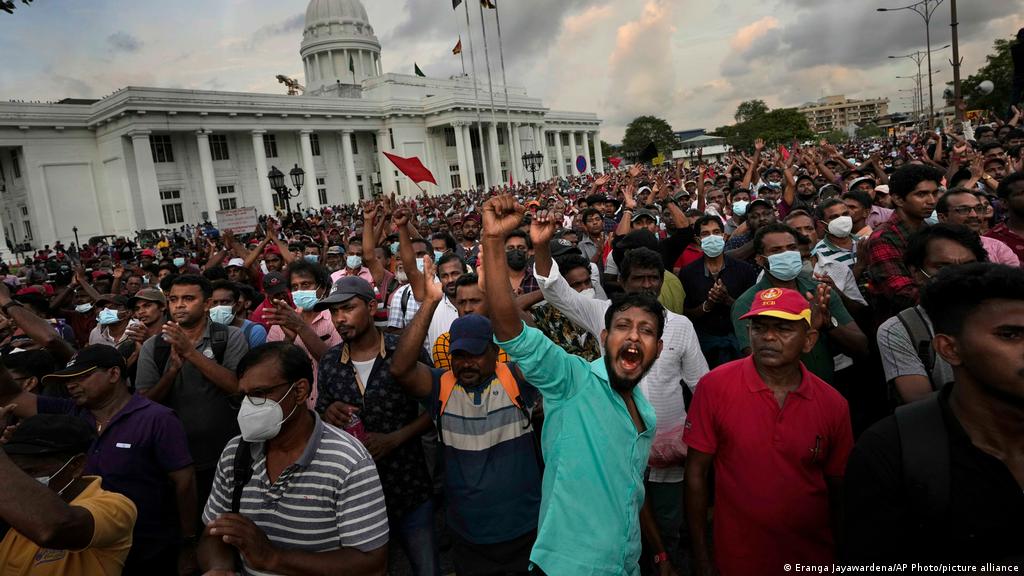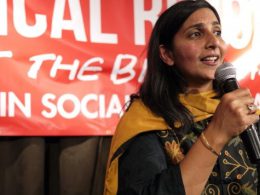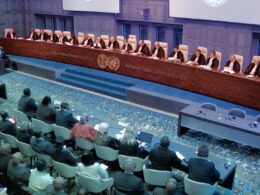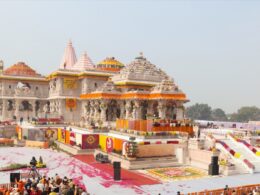By Serge Jordan
Events have taken a frenetic pace in Sri Lanka over the last 72 hours. Nothing short of a revolutionary crisis has developed, one that is likely to be a forerunner of similar upheavals in other countries.
On the morning of Monday 8th, hundreds of pro-Rajapaksa goons and lumpen bands on the government’s payroll, armed with batons, sticks and metal rods, violently assaulted two anti-government protest sites in the capital Colombo. Coming out of a meeting led by then Prime Minister Mahinda Rajapaksa at his official residence in Temple Trees, they molested people protesting for weeks in front of the residence and destroyed their camp, before descending onto the “GotaGoGama” (GGG) occupation facing the Presidential building at Galle Face Green, one kilometer away along the seaside.
Erected a month ago, this encampment had become a symbol of defiance to the regime’s authority, and a daily rallying point for all layers supporting the mass movement. The mob of pro-regime thugs unleashed extreme violence on the protesters present, torching tents and banners and bloodily beating many people. The police, present in large numbers, largely watched as the scene was taking place. “The police didn’t want to do anything” reported a Tamil woman witness to the events, adding that she was explicitly targeted for her ethnic background and endured chauvinist slurs. “We lost a lot of personal belongings, as they burnt our tents, our clothes, our blankets, everything” explained other protesters present during the assault. Dozens of them were critically injured and one youth was pronounced permanently paralysed afterwards.
Through this move, the Rajapaksa regime thought it could strike at the heart of the mass movement, intimidate peaceful protestors, and scare them away from the site — and open the door to a wider counter-offensive to break the revolt of the masses. But this turned out to be a phenomenal miscalculation. After the initial shock of the attack, thousands of youth, assisted by supportive passers-by, drivers and workers from the area, and by people who had heard of what took place, started to chase the government-sponsored hooligans into the streets to teach them a lesson. Some were undressed, thrown into the nearby Beira lake or into garbage bins; many of the buses which had been used to transport them to Colombo were set on fire, thrown into the lake, or both. The Beira lake offers now a surreal view, with a dozens of burnt out buses half-dunked into the water.
Sections of the working class immediately walked out in protest at the counter-revolutionary rampage, like the health workers from Colombo General Hospital, and the lawyers outside the Hulftsdorp court complex. Postal workers also decided to launch an island-wide strike action in response.
In defiance of the curfew announced on Monday afternoon by the government to try and push the masses off the streets —which has involved since then a very large military deployment, in the capital and in the rest of Sri Lanka— anti-government protesters fully reoccupied Galle Face Green. By 4pm “GGG” was reborn from the ruins and the tents were rebuilt, with many more people from different corners of the city flooding in waves to defend the occupation and show their solidarity, including Catholic nuns staying up all night to protect the area.
His plan having totally backfired, Mahinda Rajapaska officially stepped down in the subsequent hours. Firecrackers were set off in the suburbs of Colombo while local residents were seen cooking kiribath (milk rice, a traditional Sri Lankan dish) to celebrate the news.
After Chamal, Namal and Basil Rajapaksa —all of whom were dropped in mid-April from their Cabinet positions— Mahinda is the latest member of the Rajapaksa family to fall. He is particularly despised among the Tamil community for having overseen the massacre of tens of thousands of Tamil civilians during the civil war. Since his resignation though, the demands for his younger brother the hated President Gotabaya Rajapaksa to leave have only amplified exponentially throughout the country. So far, the incessant mixture of concessions and repressive violence deployed by the regime has failed to deter the revolutionary struggle that the workers, young and poor people of Sri Lanka have embarked upon.
Emboldened by the Prime Minister’s resignation and angered by the regime’s vicious attack, masses of people came out in protests in various parts of Colombo as in many other parts of the country. Crowds burnt down villas, houses and other properties belonging to the Rajapaksa family, leaders and MPs of the ruling party, the Sri Lanka Podujana Peramuna (SLPP). More than 50 houses of politicians were reportedly burnt overnight, and more were stormed and set on fire on Tuesday.
As I drove into Colombo on Tuesday afternoon, one of these large villas was in flames, with hundreds of people protesting outside and “Gota Go Home” tagged in red letters across the facade. In Tangalle, in the southernmost part of the country, angry protesters pulled down the statue of D.A. Rajapaksa, the father of the Rajapaksa brothers. As for Mahinda, he was evacuated from his residence after the latter was besieged by hundreds of protesters, and flown in a military helicopter to the Tamil Northeast. This then provoked protests in front of the Trincomalee Naval Base, where he is thought to have taken shelter — a naval base that was used by the Rajapaksa regime as a detention centre and torture camp for Tamils during the civil war.
At least eight people have died so far and hundreds more have been injured in the recent clashes. With their usual trope, most international media have evoked “riots” and “violence” between pro and anti-government protesters in the streets of Colombo, and western governments and embassies have urged “restraint”. But no doubt can be had about who set this violence in motion, by savagely attacking entirely peaceful and defenseless protesters, which included families with young children.
What followed next was a typical example of the “whip of the counter-revolution” triggering a revolutionary outburst. In the context of the deep suffering and exasperation at the huge economic problems facing millions of Sri Lankans, including mass shortages of fuel, gas and medicine, long-lasting power cuts and rocketing prices of food and other essential items, it is no wonder this attack spurred a furious reaction from below directed at those who live an ostentatiously luxurious lifestyle.
It is also striking that the violence of the youth was not indiscriminate. As far as could be seen, not one bus stand, small shop or ordinary people’s property were damaged in the incidents. The rage was finely oriented against the symbols and wealth of the oppressive and corrupt regime, and against its violent bootlickers.
The struggle goes on
From dawn on Tuesday, as rumours spread of regime cronies and loyalists trying to flee the country —including the second son and Chief of Staff of the now ex-Prime Minister having escaped the day before to Australia— thousands of revolutionary protesters started assembling on the roads leading to the Bandaranaike International Airport. Mostly young, with women in large numbers, many wearing helmets and armed with sticks in self-defense, they organised check-points on the main axis, patrolling the streets and searching every car, to ensure the corrupt cabal which has brought down the country to its knees is held accountable for its crimes. The soldiers stationed there, some conversing with the protesters, were watching unperturbed as it all happened. As this article is being written on the 11th May, the areas surrounding the airport still appear to be under the control of people’s patrols.
In the meantime however, the government also issued ‘shoot-on-sight’ orders against anyone damaging public property, causing harm to life or violating the curfew. This is after state forces have already been granted extended powers of arbitrary arrest and detention via the state of emergency declared last week. Since Monday, tens of thousands of heavily armed troops have amassed in Colombo, and military barrages have been erected all around, giving the atmosphere of a city under military siege — akin to what the Tamil people still experience on a daily basis in the North and East of the country. Streets in central Colombo were largely deserted today and shops, restaurants and offices were closed, a result of both the extended curfew and of the ongoing strike actions by many public and private unions.
A volatile and precarious stand-off prevails. The masses have snatched an important victory against the reaction, and a mood of embittered determination to continue the struggle until Gota falls is deeply entrenched in everyone’s minds. Yet the threat of more counter-revolutionary violence or of a wider state crackdown has far from disappeared.
At the time of writing, the army has issued a warning to the GGG occupiers to vacate the place, and the prospect of a state attack on the camp is looming in the air. The mass movement needs to fully prepare for new attempts by the regime to strike back. The protesters’ patrols which have emerged in some areas of Colombo, particularly around the airport, have been a very encouraging step in this direction. They need to take on a more organised and generalised character to protect all protests, workplaces and communities against the possibility for further attacks from pro-regime goons, the police or the army, and to make sure that the control of the streets does not remain in the hands of the state machine — which, notwithstanding the sympathy for the movement that appears to exist among some of the army ranks, is still controlled by the trigger-happy butchers who carried a genocide against the Tamil population. Striking workers and unions should put their weight behind the protection of the GGG encampment, sending delegations there urgently to help organise its defense.
The danger of communal violence, too, should be actively pushed back against. Pro-regime elements have already been seen inciting such divisions over recent days, notably in the Western city of Negombo, where Sinhalese buddhist chauvinists have tried to spread hate speech to provoke a reaction against the Muslim minority population.
The mass revolt has brought features of unity among the different layers of the population that would have been hardly thinkable up until recently. The struggle has given birth to heart-warming scenes, like when a student activist from Jaffna university was called by Sinhalese protesters to address his mostly Sinhalese audience in Tamil during the student-led blockade of the Parliament road in Colombo last week. At the GGG camp, a Sinhalese activist who had been a victim of the May 9 attack humbly explained to me, “now that we have seen what this regime can do to us, we can start to better understand what our Tamil brothers and sisters have experienced in the past”.
Having said this, the scars of the past have evidently not fully healed, and it is a fact that the heart of the movement is, for now, beating stronger in the Sinhalese majority areas of the South. Many Tamil people, while supporting the movement, are legitimately concerned that their demands for justice and reparation, for a proper trial of the criminals responsible for the mass disappearances, killings and rapes during the war, and for the Tamils’ basic right to decide their own future, could be pushed aside in a post-Rajapaksa political set-up. The movement would hence gain in strength by vocally taking up these demands, fighting for equal rights for all minorities and for the Tamils’ unconditional right to national self-determination — including their right to separate and form their own state.
All-out Hartal to bring the regime down!
The workers and trade union movement in all its diversity has a critical role to play in guaranteeing that the struggle keeps its mass, orderly, and united character. The solidarity and power displayed by all the stratums of the working class has been a remarkable feature of this struggle: from construction workers pushing pro-government buses off the streets with their excavators, to airport immigration officials joining hands to pledge not to let any government MPs or ministers pass; from the many lawyers who mobilised themselves to ensure the release of young protestors arrested by the police, to the medical staff who provided help with the injured after the attack on the GGG occupation.
The trade union alliance’s call for a “Hartal” (total strike) last Friday, May 6, was solidly embraced by the entire working class of Sri Lanka in a historic show of force that completely paralysed the island’s economy, shaking the country’s entire establishment and capitalist class. The workers from the Export-Processing Zones generated losses of $US 22 million for the big industrial manufacturers in one single day of strike! After that success, the unions had originally called for a week of protests and a new, all-out Hartal starting on Wednesday 11, demanding the President step down. From the union leaders’ perspective, this was meant to be more a threat than a plan they were fully committed to realise. Monday’s attack by the pro-government thugs and Mahinda’s resignation both precipitated and confused their plans: nationwide strike actions effectively started on Tuesday in several sectors — such as the employees of the administrative services, the railway workers, the university teachers, the health professionals — but some union leaders also used recent events to call off their strike calls.
On Wednesday, a number of additional sectors joined in, such as the harbor and electricity workers. But the strike should expand to all workplaces, and the unions should make a clear call for pickets and mass street rallies to openly defy the curfew. The current situation begs for an effective all-out Hartal until Gota Rajapaksa, his close ruling circle and his government are brought down. This is the aim that workers and all layers of the population fighting against the decaying regime should set for themselves, regardless of the half-hearted attitude of the trade union leaderships.
However, in order to achieve real change, the masses will have to go further and broaden their demands beyond the popular slogan “Gota Go Home” and the overthrow of the current President — who is the figurehead of an entire system based on economic exploitation, imperialist extortion and national oppression. They will have to reject any negotiations with the IMF, which will subordinate Sri Lanka further to its international creditors, by carrying on the vicious debt trap that is taking precious resources away from the population’s vital needs, and will be used as blackmail to impose new austerity measures set to only worsen the situation for the majority.
They will have to ensure that not only the huge wealth looted by the Rajapaksa clan is restored to the people, but that the country’s main resources and means of production and distribution are brought into public hands, under the democratic control of the working class, to reorganize and plan the economy according to the needs of all Sri Lankans.
They will have to resist any undemocratic takeover, whether by the military brass or —what appears the most likely— by a new set of unelected politicians appointed from above to preserve the system in place and stave off the mass revolt. Indeed, as this article is being finished, President Gota Rajapaksa just finished a public speech to the nation arguing that he will appoint a new cabinet this week, and that a constitutional amendment will be moved to enact the content of the 19th Amendment to the Constitution meant to vest more powers to the Parliament, and making way for the abolition of the system of executive presidency “once the country stabilises”. This is undoubtedly an umpteenth attempt to retain his grip on power, the last and central piece of insurance for the Rajapaksa dynasty to save itself from political collapse.
Faced with these incessant maneuvers, a genuine alternative needs to be forged organically, through the independent political organisation of the workers, youth, poor farmers and revolutionary masses themselves — rather than by depending on the official political opposition parties, none of which articulates an economic agenda dramatically different from the one which has led millions of Sri Lankans into such a hell in the first place.
Many protesters I spoke to expressed skepticism at best, if not utter contempt for these parties. Opposition leader Sajith Premadasa, from the right-wing and pro-business SJB (Samagi Jana Balawegaya), who is pushing himself as the next in line for the post of Prime Minister, was even attacked by protesters at Galle Face Green and had to be escorted out of the protest site by his security personnel. The JVP (Janatha Vimukthi Peramuna), for its part, confines itself to political demands on the resignation of the government, but stays largely muted over the economic issues that are crushing the Sri Lankan people.
To bring about the radical system change needed to address the dire situation experienced by millions of people across Sri Lanka, ISA demands:
- All-out Hartal to bring down Gota Rajapaksa and the whole ruling family! Immediate travel bans for all the regime cronies — return the stolen assets and seize all their properties and wealth;
- For an end to the state of emergency — stop the militarisation — troops off the streets in all parts of Sri Lanka;
- Abolish the executive presidency and the current constitution — for a revolutionary constituent assembly based on fully free elections in all parts of the island;
- Build action and self-defense committees in all workplaces, protest sites, neighborhoods and villages;
- No negotiation with the IMF and no to more austerity measures — unconditional cancellation of the country’s debts;
- Impose price controls, with a massive hike in wages across all sectors;
- Public monopoly on foreign trade and nationalization, under workers’ control, of the key industries, land estates and banks. For a socialist economy democratically planned by working and farming people, and a government made up of their elected representatives;
- No to communal divisions — for a united movement of all workers, poor and oppressed sections of society;
- Defend the right of self-determination for the Tamil people, including the right to their own state. Full justice and adequate compensation for the victims of the war and return of all occupied land. Popular trials to judge the war criminals — reveal the full truth on the killings and forced disappearances;
- International solidarity with the mass uprising in Sri Lanka.












